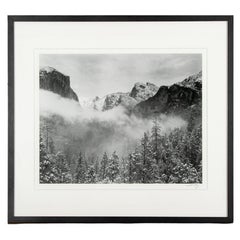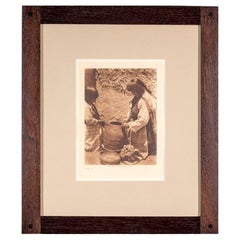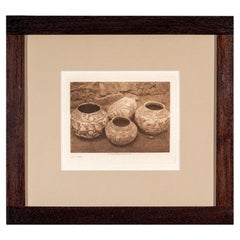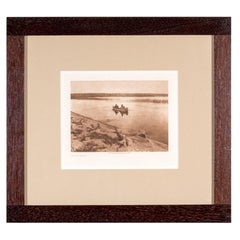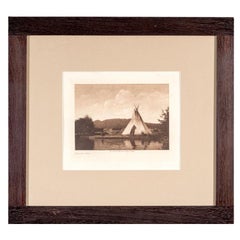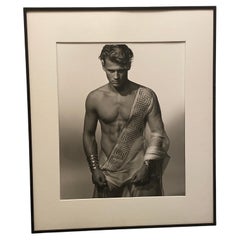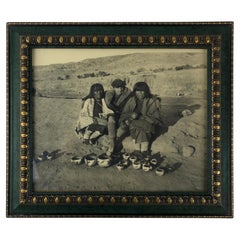Black Rock Galleries Photography
to
14
11
3
Height
to
Width
to
2
2
11
3
2
14
11
10
8
2
14
14
14
14
14
7
2
1
Robert Werling (American, B.1946) Black And Photograph, Mountain Landscape
By Robert Werling
Located in Bridgeport, CT
Pencil signed lower right. A mountain landscape with the mist over the forest in the winter. He is known for his mountain views in the American west
full paper Site 14 3/4” x 18 1/2...
Category
20th Century American Rustic Photography
Materials
Wood, Paper
Ann Stautberg (Am. B. 1949) Monumental Photographic Work “4.09.02, A.M. Shanghai
Located in Bridgeport, CT
Ann Stautberg, a Houston artist that combines her photographs, which she hand colors using translucent oils, with her love for painting. The combined technique is visible here in thi...
Category
21st Century and Contemporary American Organic Modern Photography
Materials
Acrylic, Wood, Paper
Edward S. Curtis (1868-1952) Scarce Sepia Photogravure Titled Tsipiai - Sia
By Edward S. Curtis, 1868-1952
Located in Bridgeport, CT
Sepia photogravure titled "Tsipiai - Sia" depicting native women engaged in pottery making.
The photogravure is titled lower left "Tsipiai - Sia". Printed under the photogravure "Fro...
Category
20th Century American Native American Photography
Materials
Acrylic, Wood, Paper
Edward S. Curtis (1868-1952) Scarce Sepia Photogravure Titled "Zuni Pottery"
By Edward S. Curtis, 1868-1952
Located in Bridgeport, CT
Sepia photogravure titled "Zuni Pottery" depicting a collection of Zuni pottery on the ground set against a stone wall.
The photogravure is titled lower l...
Category
20th Century American Native American Photography
Materials
Acrylic, Wood, Paper
Edward S. Curtis (1868-1952) Scarce Sepia Photogravure Titled "Cree Boatwomen"
By Edward S. Curtis, 1868-1952
Located in Bridgeport, CT
Sepia photogravure titled "Cree Boatwomen" depicting Native American women in boat on a lake.
The photogravure is titled lower left "Cree Boatwomen". Printed under the photogravure "...
Category
20th Century American Native American Photography
Materials
Acrylic, Wood, Paper
Edward S. Curtis (1868-1952) Scarce Sepia Photogravure Titled "Kalispel Camp"
By Edward S. Curtis, 1868-1952
Located in Bridgeport, CT
Sepia photogravure titled "Kalispel Camp" depicting native figures in the foreground with kayak and teepee and rolling hills in the distance.
The photogravure is titled lower left "K...
Category
20th Century American Native American Photography
Materials
Acrylic, Wood, Paper
Edward S. Curtis (1868-1952) Rare Sepia Photogravure Titled "Spotted Elk - Brule
By Edward S. Curtis, 1868-1952
Located in Bridgeport, CT
Sepia photogravure titled "Spotted Elk - Brule" depicting a portrait of Spotted Elk from the Brule tribe.
The photogravure is titled lower left "Spotted Elk - Brule". Printed under t...
Category
20th Century American Native American Photography
Materials
Acrylic, Wood, Paper
Edward S. Curtis (1868-1952) Sepia Photogravure "Touch Her Dress - Kalispel"
By Edward S. Curtis, 1868-1952
Located in Bridgeport, CT
Sepia photogravure titled "Touch Her Dress - Kalispel" depicting the portrait of a young native girl. The Kalispel Tribe from areas that encompassed lands that stretched from Montana...
Category
20th Century American Native American Photography
Materials
Acrylic, Wood, Paper
Edward S. Curtis (1868-1952) Rare Sepia Photogravure Titled Atsina War-Party
By Edward S. Curtis, 1868-1952
Located in Bridgeport, CT
Sepia photogravure titled "Atsina War-Party" depicting Native Americans on their horses over-looking the grasslands in the distance.
The photogravure is titled in plate lower left "A...
Category
20th Century American Rustic Photography
Materials
Acrylic, Wood, Paper
Aaron Siskind Signed Silver Gelatin Print Chicago 1952
By Aaron Siskind
Located in Bridgeport, CT
Originally a documentary photographer, Aaron Siskind turned away from representation and towards abstraction in the 1940s, using his camera to capture the graphic patterns, shapes, a...
Category
Mid-20th Century American Photography
Materials
Steel
Aaron Siskind Silver Gelatin Prints Avizpe 1966
By Aaron Siskind
Located in Bridgeport, CT
Originally a documentary photographer, Aaron Siskind turned away from representation and towards abstraction in the 1940s, using his camera to capture the graphic patterns, shapes, a...
Category
Mid-20th Century American Mid-Century Modern Photography
Materials
Steel
Luis Gallo (Cuba, B.1962) Set 10 Black & White Photographs, "Passengers" Series
Located in Bridgeport, CT
From Luis Gallos 1994-1995 Series .A set from his large series of black and white photographs of riders in the NYC subway. Each rider wears a coat and has hands in a different pose, ...
Category
20th Century American Mid-Century Modern Photography
Materials
Glass, Wood, Paper
Jody Dole 'Am., NY-CT, 20-21st C.' Signed Ltd Ed Studio Photo Print, CT Barn
Located in Bridgeport, CT
Signed lower right, numbered 8/100 lower left. Label on verso with title- Barn- Bushnell Farm, Saybrook CT 2013, printed 2014. The old weathered barn on...
Category
21st Century and Contemporary American Modern Photography
Materials
Paper
Jody Dole 'Am. NY- CT, 20th-21st C.' Signed Ltd Ed Studio Photo Print, Nantucket
Located in Bridgeport, CT
Signed lower right, numbered 38/100 lower left. Label on verso dated 2012, printed in 2014. An energetic view of a wind swept Nantucket landscape i...
Category
21st Century and Contemporary American Modern Photography
Materials
Glass, Wood, Paper
Related Items
Michael Roberts Original Photograph "Michel Greek Toga" Hamilton's London, 1989
By Michael Roberts
Located in Palm Springs, CA
PLEASE NOTE:
This original photo from the amazing Michael Roberts exhibition at Hamilton's Gallery in London, England of "Michel in a Toga" was used in promotional pieces for the exhibit. It is signed/ nuymbered 1/25, but this is the actual photograph from the exhibit, and no other image was made/printed. IT IS AN AMAZING IMAGE. * This image of Michel wearing a sheer greek key toga. He is nude underneath and although subtle, it is a nude. Michel was a high fashion male model thet Michael Roberts adored and used him for many fashion campains for Joeph's London. A rare large black and white hand printed silver gelatin photograph of Michel by the legendary fashion icon, Michael Roberts, London. This image was part of a Michael Roberts show in 1989 at Hamilton's gallery, London. Signed on back. Black metal simple frame. Image: 15" x 19", framed: 22' x 26".
This image was in the gallery show in London.The images from the show are very rare and now highly sought after and collected after Mr. Robert's death. two images were purchased from that Exhibit. The second one, "Nude of Michel" is available on separate listing. We hope they are purchased together as they were hung next to each other in the exhibit.
MICHAEL ROBERTS:
The preferred medium of the fashion journalist Michael Roberts was Canson art paper, which he scissored freehand into crisp-cut collages, or snipped into minute dots to reassemble into mosaics, for magazine covers or book illustrations. His art, bit by bit putting it together, reflected his life in fashion. He wrote about it, commissioned unexpected others to do so, photographed for media and ads, and charmed cranky legendary lensmen into snapping for him. He could source the clothes, choose the crazy locale, stage the shoot’s story, and write a witty critique of the enterprise. He was also always the most elegant person involved, effortlessly cool.
Roberts, who has died aged 75, never bothered with a résumé, since every new role or venture seemed to just develop, but they totted up to a serious career. He was a writer on the Sunday Times in the 1970s, when new couture catwalk drama and heightened designer celebrity demanded a fashion voice that was both theatre critic and gossip columnist. Then from 1979 he was art and style director of Tatler magazine, when the editor, Tina Brown...
Category
Vintage 1980s English Modern Photography
Materials
Paper
$3,800 Sale Price
20% Off
H 26 in W 22 in D 0.75 in
Historical B/W Photograph of Native American Navajo Pottery Makers
Located in Miami, FL
A Window into History: 1922 Portrait by Odile Bouligny
This captivating black and white photograph, captured in 1922 by renowned French photographer Odile Bouligny, offers a glimpse into a bygone era. The image portrays a mother and daughter, both Navajo pottery...
Category
Early 20th Century American Art Deco Native American Objects
Materials
Paper
$2,900 Sale Price
41% Off
H 12.88 in W 15 in D 0.88 in
Michael Roberts Original Photograph "Michel Nude" Hamilton's London, 1989
By Michael Roberts
Located in Palm Springs, CA
MICHAEL ROBERTS (1947-2023)
PLEASE NOTE: This photograph is a one of a kind original photograph. Every photograph in the show was available to purchase, and only one of each was printed. This large black and white hand printed silver gelatin photograph of "Michel Nude" by the legendary fashion icon, Michael Roberts, London. This image was part of a Michael Roberts show in 1989 at Hamilton's gallery, London. Signed on back. Black metal simple frame. Image: 15" x 19", framed: 22' x 26".
This image is one of two that were in the gallery show in London. The images from the show were very rare and now highly sought after and collected after Mr. Robert's death but there are NONE available to purchase. These two images were purchased from that Exhibit from Hamiltons. The second one, "Nude of Michel" is available on separate listing. We hope they are purchased together as they were hung next to each other in the exhibit.
MICHAEL ROBERTS:
The preferred medium of the fashion journalist Michael Roberts was Canson art paper, which he scissored freehand into crisp-cut collages, or snipped into minute dots to reassemble into mosaics, for magazine covers or book illustrations. His art, bit by bit putting it together, reflected his life in fashion. He wrote about it, commissioned unexpected others to do so, photographed for media and ads, and charmed cranky legendary lensmen into snapping for him. He could source the clothes, choose the crazy locale, stage the shoot’s story, and write a witty critique of the enterprise. He was also always the most elegant person involved, effortlessly cool.
Roberts, who has died aged 75, never bothered with a résumé, since every new role or venture seemed to just develop, but they totted up to a serious career. He was a writer on the Sunday Times in the 1970s, when new couture catwalk drama and heightened designer celebrity demanded a fashion voice that was both theatre critic and gossip columnist. Then from 1979 he was art and style director of Tatler magazine, when the editor, Tina Brown...
Category
Vintage 1980s English Modern Photography
Materials
Paper
$3,600 Sale Price
20% Off
H 26 in W 22 in D 0.75 in
Black & White Photograph of "Thumbs Up" by Robert Francis Giandomenico, c. 1970
Located in Philadelphia, PA
Black & White Photograph of "Thumbs Up"
by Robert Francis Giandomenico, c. 1970
Photograph is mounted on Board
"thumbs up emoji before the thumbs up emoji"
"unframed - will look a...
Category
Vintage 1970s American Post-Modern Photography
Materials
Paper
$225
H 13.75 in W 10.75 in D 0.13 in
Edward S Curtis (1868-1952) As It Was In The Old Days, 1927
By Edward S. Curtis, 1868-1952
Located in CA, CA
Edward S Curtis (1868-1952)
Title: As It Was In The Old Days
Plate: 652
Portfolio: Volume 19
Printer: Suffolk Eng. Co. Cambridge Mass
Medium: Photogravure
Date: 1927
Dimensions:
S...
Category
Vintage 1920s American American Colonial Photography
Materials
Paper
Vintage Native American Photograph
Located in Brooklyn, NY
Vintage Native American photograph, circa 1960
Silver Gelatin Print
16 x 20 inches.
Unsigned from unknown photographer
Very good cond...
Category
Vintage 1940s American Native American Photography
Materials
Paper
Modernist Nude Woman Photogravure Early 20th Century
Located in Rochester, NY
Modernist nude photogravure. Circa 1910. Nicely framed and matted. Silver leaf frame.
Category
Early 20th Century Photography
Materials
Paper
Brassai's Insight: Photogravure of Picasso's Sculpture, circa 1948
By Brassaï, Pablo Picasso
Located in Barcelona, Barcelona
Brassai's Insight: Photogravure of Picasso's Sculpture, circa 1948
From 1948
Photography by Brassai
Photogravure
From 'The Sculptures of Picasso' by Daniel Henry Kahnweiler
Printed ...
Category
Vintage 1940s Spanish Mid-Century Modern Photography
Materials
Paper
$1,063 Sale Price
40% Off
H 12.21 in W 9.45 in D 1.38 in
Edward S. Curtis Native American Print “Cowichan Warrior”, John Andrew & Son
Located in Big Flats, NY
Antique Edward S. Curtis Native American Print “Cowichan Warrior” C1912 (26 1/2" x 18" x 1/4").
This is an antique print titled 'Cowichan Warrior' by Edward S. Curtis, created...
Category
Early 20th Century Photography
Materials
Paper
$750
H 26.5 in W 18 in D 0.25 in
Edward S Curtis, Autumn - Apsoroke, 1908
By Edward S. Curtis, 1868-1952
Located in CA, CA
Edward S Curtis (1868-1952)
Title: Autumn - Apsaroke
Plate: 130
Portfolio: Volume IV
Printer: John Andrew & Son
Medium: Photogravure
Date: 1908
Edwar...
Category
Antique Early 1900s American American Classical Photography
Materials
Paper
"Charros" Black and White Photograph by Nicole Franco
Located in Dallas, TX
Nicole Franco
"Charros"
25x37in print
San Miguel De Allende, Mexico, 2014
Edition 1/10
Fine Art Archival Print
Printed on Sahnemühle
Category
2010s Mexican Photography
Materials
Paper
Brassai Framed Heliogravure Photography (1949) - Black and White
By Brassaï
Located in Barcelona, Barcelona
Brassai Framed Heliogravure Photography (1949) - Black and White
Artist: Brassai
Type: Framed heliogravure photograph
Color: Black and white
Dimensions: H 29.5 x W 24.5 x D 3.5 cm
S...
Category
Vintage 1940s French Mid-Century Modern Photography
Materials
Paper
$885 Sale Price
40% Off
H 11.62 in W 9.65 in D 1.38 in
